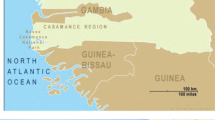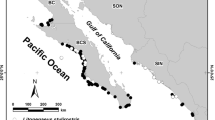Abstract
Waders residing in the Dutch Wadden Sea had high selenium concentrations in the tissues. These high concentrations may be a result of a contamination in the food chain, and a selection of marine invertebrate prey animals, the bivalves Macoma balthica and Mytilus edulis and the polychaete Nereis diversicolor, were analyzed for selenium. Selenium concentrations varied by year, season, location, species and size, but the average concentrations (2–6 mg/kg ash free dry weight) remained within the range of known background concentrations in marine invertebrates (1–10 mg/kg DW). However, the highest concentrations approximate the general (sub)toxic level of dietary selenium. The importance of the determination of the selenium compound(s) in marine biota is stressed
Macoma had a seasonal variation in selenium concentration that may parallel the reproductive cycle; the highest concentrations (4–5 mg/kg AFDW) were found in the spawning period, the concentration dropped after spawning and in the recovery phase the bivalves were lowest in selenium (2–3 mg/kg AFDW). Intermediate concentrations (3–4 mg/kg AFDW) were measured during the gametogenesis. Concentrations changes in Mytilus corresponded with this pattern.
Similar content being viewed by others
References
Arnold RL, Olson OE, Carlson CW (1973) Dietary selenium and arsenic additions and their effects on tissue and egg selenium. Poultry Sci 52:847–854
Cramp S, Simmons KEL (1983) The birds of the western Palearctic. Vol 3. Oxford Univ Press, London
Beukema JJ (1981) The baltic tellin Macoma balthica. In: Dankers N, Kühl H, Wolff WJ (eds) Invertebrates of the Wadden Sea. Balkema AA, Rotterdam, pp 116–118
Beyer WN, Cromartie EJ (1987) A survey of Pb, Cu, Zn, Cd, Cr, As, and Se in earthworms and soil from diverse sites. Environ Monit Assess 8:27–36
Beyer WN, Hensler G, Moore J (1987) Relation of pH and other soil variables to concentrations of Pb, Cu, Zn, Cd, and Se in earthworms. Pedobiologia 30:167–172
Brügmann L, Lange D (1988) Trace metal studies on the starfish Asterias rubens L. from the western Baltic Sea. Chem Ecol 3:295–311
Eisler R (1985) Selenium hazards to fish, wildlife, and invertebrates: a synoptic review. Contam Hazard Rev, Report no 5, Fish and Wildlife Service, U.S. Dept. of the Interior
— (1988) Arsenic hazards to fish, wildlife and invertebrates: a synoptic review. Contam Hazard Rev, Report no 12, Fish and Wildlife Service, U.S. Dept. of the Interior, Washington, DC
Fowler BA, Fay BC, Walter RL, Willis RD, Gutknecht WF (1975) Levels of toxic metals in marine organisms collected from southern California coastal waters. Environ Health Persp 12:71–76
Gissel Nielsen M, Gissel Nielsen G (1975) Selenium in soil-animal relationships. Pedobiologia 15:65–67
Goede AA (1985) Mercury, selenium, arsenic and zinc in waders from the Dutch Wadden Sea. Environ Pollut 37:287–309
Goede AA, Nygard T, de Bruin M, Steinnes E (1989) Selenium, mercury, arsenic and cadmium in the lifecycle of the dunlin Calidris alpina, a migrant wader. Sci Total Environ 78:205–218
Goede AA (1992) Element profiles of feathers identify Knot populations, but the mystery of arsenic emerges. Wader Study Group Bull 64, Suppl: 26–28
— (1993) Selenium in eggs and parental blood of a Dutch marine wader. Arch Environ Contam Toxicol 25:79–84
Heinz GH, Hoffman DJ, Gold LG (1989) Impaired reproduction of mallards fed an organic form of selenium. J Wildl Manage 53:418–428
Hoffman DJ, Heinz GH (1988) Embryotoxic and teratogenic effects of selenium in the diet of mallards. J Toxicol Environ Health 24:477–490
Hoffman DJ, Sanderson CJ, LeCaptain LJ, Cromartie E, Pendleton GW (1992) Interactive effects of arsenate, selenium, and dietary protein on survival, growth, and physiology in mallard ducklings. Arch Environ Contam Toxicol 22:55–62
Hothem RL, Ohlendorf HM (1989) Contaminants in foods of aquatic birds at Kesterson Reservoir, California, 1985. Arch Environ Contam Toxicol 18:773–786
Lammens JJ (1967) Growth and reproduction in a tidal flat population of Macoma balthica (L.). Neth J Sea Res 3:315–382
Levander OA (1987) A global view of human selenium nutrition. Ann Rev Nutr 7:227–250
Liu DL, Yang YP, Hu MH, Harrison PJ, Price NM (1987) Selenium content of marine food chain organisms from the coast of China. Mar Environ Res 22:151–165
Micallef S, Tyler PA (1989) Levels and interactions of selenium with group IIb metals in mussels from Swansea Bay, South Wales, UK Bull Environ Contam Toxicol 42:344–351
Mikac N, Picer M, Stegnar P, Tusek-Znidaric M (1985) Mercury distribution in a polluted marine area, ratio of total mercury, methyl mercury and selenium in sediments, mussels and fish. Water Res 19:1387–1392
Ohlendorf HM, Hoffman DJ, Saiki MK, Aldrich TW (1986) Embryonic mortality and abnormalities of aquatic birds: Apparent impacts of selenium from irrigation drainwater. Sci Total Environ 52:49–63
Ohlendorf HM, Kilness AW, Simmons JL, Stroud RK, Hoffman DJ, Moore JF (1988) Selenium toxicosis in wild aquatic birds. J Toxicol Environ Health 24:67–92
Shamberger RJ (1981) Selenium in the environment. Sci Total Environ 17:59–74
Smith GJ, Heinz GH, Hoffman DJ, Spann JW, Krynitsky AJ (1988) Reproduction in black crowned night-herons fed selenium. Lake Reserv Manage 4:175–180
Zandee DI, Kluytmans JH, Zurburg W (1980) Seasonal variations in biochemical composition of Mytilus edulis with reference to energy metabolism and gametogenesis. Neth J Sea Res 14:1–29
Zwarts L (1988) De bodemfauna van de Fries-Groningse waddenkust. Flevobericht nr. 294. Rijksdienst IJsselmeerpolders, Lelystad, ISBN 90–369–1042–0.
Author information
Authors and Affiliations
Rights and permissions
About this article
Cite this article
Goede, A.A., Wolterbeek, H. & Koese, M.J. Selenium concentrations in the marine invertebrates Macoma balthica, Mytilus edulis, and Nereis diversicolor . Arch. Environ. Contam. Toxicol. 25, 85–89 (1993). https://doi.org/10.1007/BF00230716
Received:
Issue Date:
DOI: https://doi.org/10.1007/BF00230716




